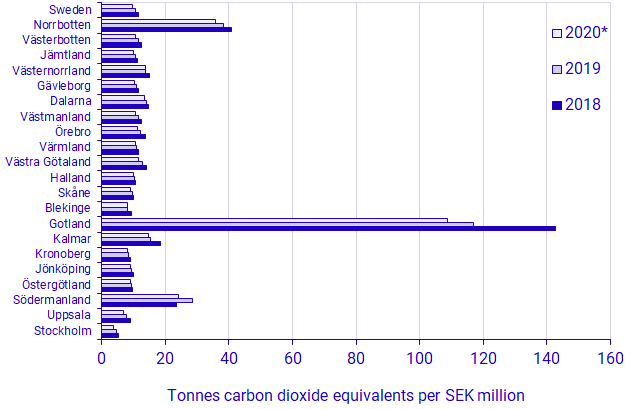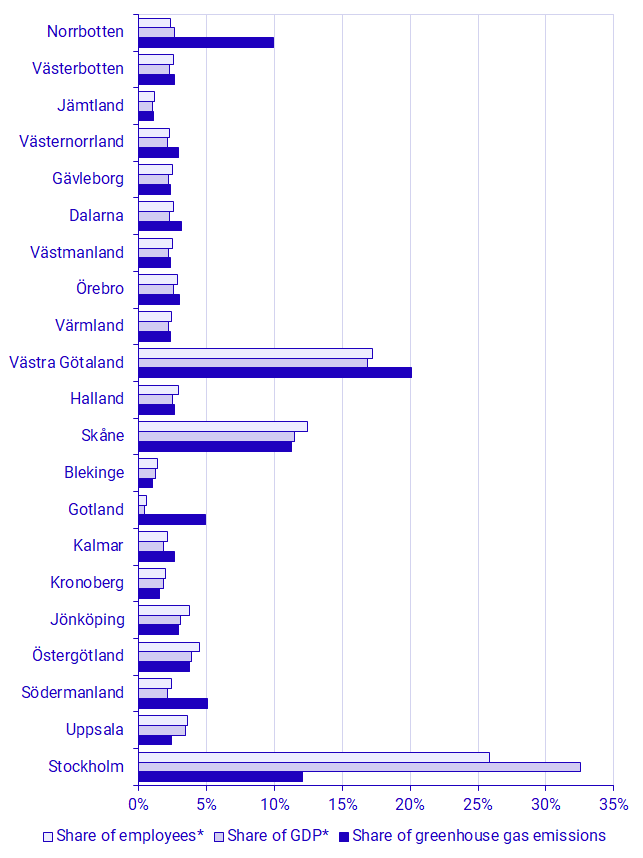Environmental accounts – Emissions to air 2020, regional statistics
Regional greenhouse gas emissions are decreasing
Statistical news from Statistics Sweden 2022-11-24 8.00
Greenhouse gas emissions at a regional level in Sweden are decreasing in 2020 compared to 2019. The manufacturing industry decreases its emissions across the whole country. The effect of the coronavirus pandemic on the Swedish air transport sector is reflected in a large emission decrease in Stockholm county and Västra Götaland county.
– During 2020, greenhouse gas emissions are decreasing in all Swedish regions. This decrease becomes particularly evident in the regions where air transport or heavy industrial sectors operate. Even the relatively mild winter of 2020 may have contributed to reduced emissions, says Dimitra Kopidou, analyst at Statistics Sweden environmental accounts.
Regional greenhouse gas emissions based on their economic activity in 2020
In 2020, greenhouse gas emissions from the Swedish economy amount to 47.6 million tonnes of carbon dioxide equivalents, which is a decrease of 5.7 million tonnes compared to 2019. Emissions decrease in all Swedish regions. However, the largest decreases occur in Stockholm county and Västra Götaland county, by 1.8 and 1.2 million tonnes of carbon dioxide equivalents, respectively. The reduced emissions from air transport – due to the coronavirus pandemic – contribute significantly to lower total emissions in these two counties.
Västra Götaland county has the largest share of emissions in the whole country in 2020. Specifically, 9.6 million tonnes of carbon dioxide equivalents are emitted, which correspond to 20 percent of the total emissions in Sweden. Stockholm, Skåne and Norrbotten counties follow with 5.7 million, 5.4 million and 4.7 million tonnes of carbon dioxide equivalents, respectively. These account for a share of 12, 11, and 10 percent of the total emissions in Sweden, respectively.
Emission intensity by county
The emission intensity, which measures the amount of greenhouse gases emitted per unit of gross regional product, decreases in all counties except Västernorrland in 2020. The largest emission intensity reduction between 2019 and 2020 is noted in Stockholm county, where the emission intensity decreases by 24 percent. Södermanland county follows with a 15 percent decrease in its emission intensity.
In general, the emission intensity differs between the counties in the reported year. In the Gotland county, the emission intensity is 108.8 tonnes of carbon dioxide equivalents per million SEK, while the emission intensity in the Stockholm county is 3.5 tonnes of carbon dioxide equivalents per million SEK. In the country as a whole, the emission intensity is 9.6 tonnes of carbon dioxide equivalents per million SEK. The variation in the energy intensity levels between the counties is explained by the diverse establishment of highly intensive industries across the country.

* The 2020 gross regional product is preliminary.
Source: SCB
Environmental economic profile by county
An environmental economic profile can be used to provide a general description of a county’s environmental economic structure. This profile shows the county’s share of Sweden’s gross domestic product (GDP), greenhouse gas emissions and employees.
In many counties, the share of greenhouse gas emissions is roughly the same as the share of employees and the share of GDP. The counties of Västra Götaland, Norrbotten, Södermanland, and Gotland, on the other hand, have emission-intensive profiles, in which the share of greenhouse gas emissions is larger than the share of employees and of GDP. This is due to emission-intensive industries and/or numerous shipping companies in these counties.
In Västra Götaland county, levels of output of both goods and services are high. This leads to a high share of employees, GDP and greenhouse gas emissions. Meanwhile, in Norrbotten county, the share of employees and GDP are smaller, but the share of greenhouse gas emissions is high. This is due, in part, to the presence of manufacturing industries with high emissions and few employees.
In Stockholm county, there is a high share of employees and high contributions to GDP. The largest industries in Stockholm county are in service sectors, in which the levels of greenhouse gas emissions are relatively low.

* The 2020 gross domestic product and employees are preliminary data.
Source: SCB
Definitions and explanations
Environmental Accounts publishes regional emissions to air per industrial sector at regional, county and municipal level. The statistics include emissions, emission intensities and environmental economic profiles. The statistics follow the framework of the national accounts, which means the emissions are linked to the economic activity responsible for the emissions. This does not necessarily imply that the emissions actually occur in a specific region, but rather that the actor responsible for the emissions is located there.
The Environmental Accounts are compiled according to the framework of the System of Environmental and Economic Accounts (SEEA) and show national environmental statistics and economic statistics in the same framework using NACE industry classification. The starting point is Swedish economic actors’ environmental pressures, irrespective of where in the world they occur.
Therefore, a residence adjustment is applied to adjust statistical sources with a territorial perspective used to produce these statistics to the national and environmental accounts’ economic perspective. The residence adjustment applies primarily to transport: heavy duty road transport (primarily within H49 land transport companies, but also in other industries, such as construction (F41-43)), water transport (H50) and air transport (H51). Further information about the residence adjustment can be found in the document (in Swedish) concerning the quality of the statistics on the Environmental Accounts webpage. These statistics are also explained in more detail in the Environmental Accounts Statistical Report 2017:2 Regional Environmental Accounts 2008–2015.
These statistics on air emissions are reported based on a production perspective. Emissions are reported for the industry from which emissions occur. Indirect emissions from imports and other consumption of goods and services are not included.
Regional statistics on air emissions reported by the SMHI refer to territorial emissions, that is emissions that occur within the boundaries of each region. This means that SMHI’s statistics can be used to monitor air pollution levels in a specific area.
Next publishing will be
The next publication of regional statistics on air emissions is scheduled for autumn 2023.
Statistical Database
More information is available in the Statistical Database
Feel free to use the facts from this statistical news but remember to state Source: Statistics Sweden.
